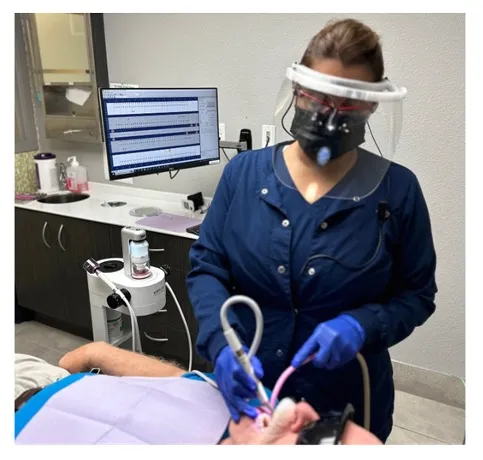As a periodontist, I often get asked, “What makes a “cleaning” appointment at your office different?” This is a great question, and although it may seem easy to answer, my answers often lead to a great discussion about why we do what we do. In this article, I will share the criteria I use in selecting instruments or protocols for my hygiene department.
In our office, we are committed to giving patients the very best in dental care. This means we utilize protocols, treatment modalities, and instruments proven to help patients.
Each periodontal maintenance visit includes:

I would like to review each step in the protocol on why we do what we do.
I have a hard cut-off for blood pressure because we believe our patients’ overall health is our top priority. We communicate blood pressure parameters (anything above <160 mm Hg/and or <100 mm Hg) at the patient’s first appointment and cancel future appointments if the blood pressure is out of range. The patient is then referred to their physician to stabilize their blood pressure. While this can be frustrating for all involved, both the patient and provider, we do this intentionally. Blood pressure is labeled as the “silent killer” for good reason. If I allowed our patient to be treated with blood pressure outside these parameters, I would communicate that blood pressure is unimportant. I want our messaging to communicate that patients’ systemic and oral health are important, and both require professional help. If I went against my guidelines, I would also communicate that I don’t care.
The pre-procedural rinse has been used for many years to reduce bacterial load in the patients’ mouth pre-treatment. The rinse also reduces aerosolized bacteria and thereby reduces inhaling bacteria for both the patient and hygienist.
Proper home care is vital in treating and managing periodontal disease. After showing our patients where they are not cleaning, we review techniques that will facilitate plaque removal, reducing the likelihood of periodontal disease progression. Proper home care is a fundamental component in periodontal disease management. It is surprising the number of patients, some in their 60’s and 70’s, who comment to us that no one has ever shown them how to brush their teeth properly! Patients who come to my practice want to keep their teeth and get frustrated when they don’t seem to be making progress in controlling the disease. It is so important to talk about the basics, which are easy to overlook yet so crucial in periodontal disease management.
This step uses a high-pressure stream of air and water mixed with a specially formulated powder to polish and clean the teeth’s surfaces. It is like a micro-pressure washer! It is particularly effective at removing the biofilm, stains, and discoloration. The treatment is gentle and comfortable for patients, too. Periodontal disease is a biofilm disease; when we use only hand instruments or ultrasonics, we leave portions of the tooth untreated. Incomplete removal can lead to faster re-colonization of the pathogenic bacteria. Studies have shown that this treatment is far more effective at minimizing recolonization of the pathogenic bacteria.
There are several reasons why we use a piezo ultrasonic. Firstly, it tends to be more comfortable. The instrument path is less varied using a piezo. Secondly, magnetostrictive can actually remove tooth structure in addition to calculus and is a more aggressive instrument. This is a problem when we want to be as conservative as possible. In our office, we have committed to using the most conservative instruments and techniques.
You may have noticed that we do not use a prophy cup. Why? It actually removes enamel because of the abrasive nature of prophy paste. Once again, we want to conserve enamel, not take it away.
In formulating our periodontal maintenance protocol, we have meticulously defined the periodontal maintenance provided by our hygienist. Our philosophy, methodology, and techniques have been thoughtfully chosen and thoroughly reviewed to underscore the significance of systemic health. This is achieved through the careful management of high blood pressure, reducing exposure to aerosolized bacteria, effectively identifying problematic areas for our patients, educating them on enhancing their home care practices, utilizing precise instrumentation for the removal of pathogenic calculus, and minimizing tooth structure removal by employing a piezo scaler rather than a prophy cup.
Our patients appreciate these concerted efforts, and many have observed a noticeable transformation in the way we maintain their periodontal health – often for the first time in their lives.
Chris Bingham, DDS, MS